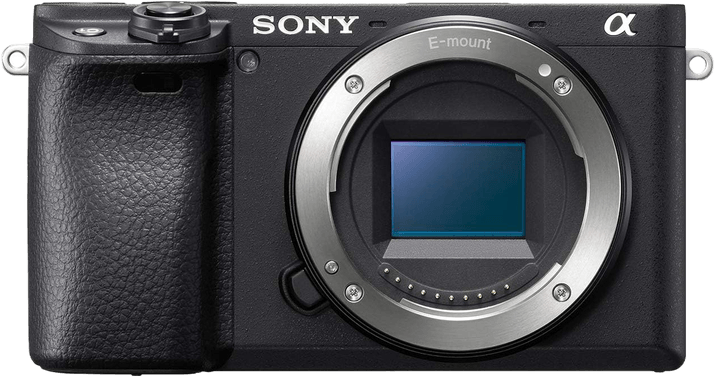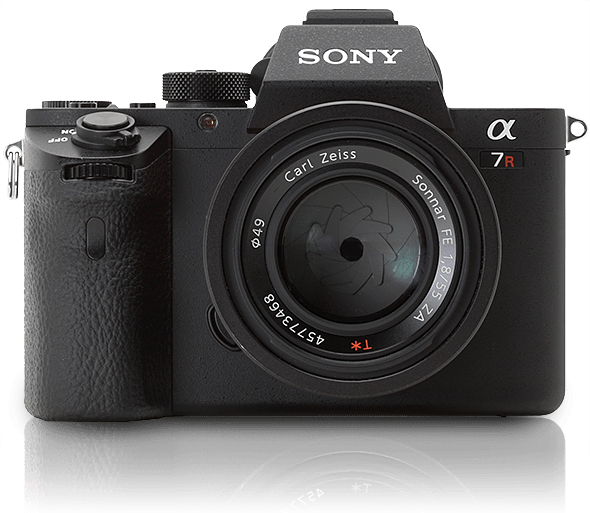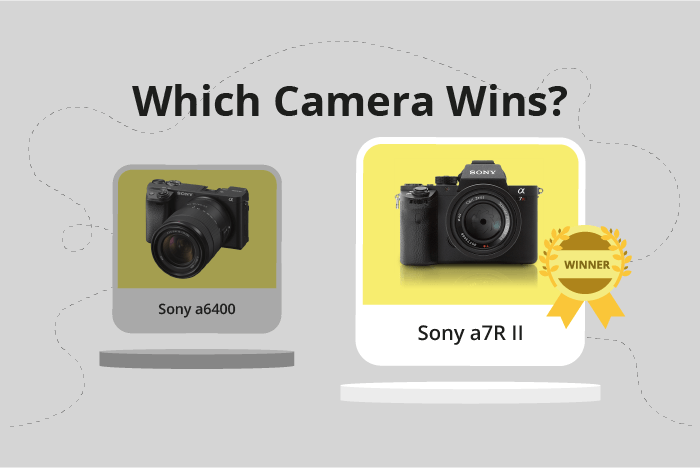Sony a6400 vs a7R II Comparison
Sony a6400

Sony a7R II

The Sony a6400 and Sony a7R II both scored 70/100, making them equal in our evaluation. These mirrorless cameras share similarities such as their camera type and identical scores. However, differences in their specifications can be observed.
The Sony a6400, released in 2019, has a lower launch price of $900 and is lighter, weighing 403g (0.89lbs). Its dimensions are 120 x 67 x 60mm, making it more compact than the a7R II. These features make the a6400 more affordable and portable.
On the other hand, the Sony a7R II, released in 2015, has a higher launch price of $3198 and is heavier, weighing 625g (1.38lbs). Its dimensions are 127 x 96 x 60mm, making it slightly larger than the a6400. Despite these downsides, some users may prefer the a7R II for its build quality and features that justify the higher price.
Choosing between these cameras depends on individual preferences, such as budget and portability. Both cameras perform well, but the Sony a6400 offers a more affordable and lightweight option, while the Sony a7R II caters to users seeking more advanced features at a higher price.
Sony a6400 vs a7R II Overview and Optics
The Sony a7R II triumphs over the Sony a6400 in optics with a score of 81/100 compared to the a6400’s 68/100. Both cameras share several specifications such as a CMOS sensor, Bionz X processor, and a compatible lens mount – Sony E for the a6400 and Sony FE for the a7R II.
The a7R II outperforms the a6400 in several aspects. It boasts a higher megapixel count of 42.4, allowing for more detailed and sharper images. The full-frame sensor size in the a7R II also contributes to better image quality, particularly in low light situations. Additionally, the a7R II has a higher DXOMARK sensor score of 98, which reflects its superior image quality. Furthermore, the a7R II features image stabilization, which helps in reducing camera shake and improving image sharpness.
On the other hand, the Sony a6400 has a faster shooting speed of 11 frames per second, compared to the a7R II’s 5 frames per second. This makes the a6400 more suitable for capturing fast-paced action or sports photography. However, this advantage does not compensate for the overall superior optics of the a7R II.
Considering the optics, the Sony a7R II is the clear winner due to its higher megapixel count, full-frame sensor, better DXOMARK score, and image stabilization. These features contribute to better image quality and performance. The Sony a6400, with its faster shooting speed, may be more suitable for specific situations like action photography, but it does not surpass the a7R II in terms of optics.
Sony a6400 vs a7R II Video Performance
The Sony a6400 emerges as the clear winner in the video capabilities comparison, boasting a video score of 91/100, while the Sony a7R II lags behind with a score of 56/100. Both cameras share some common video specifications, such as a maximum video resolution of 4K and video dimensions of 3840 x 2160. However, the Sony a6400 surpasses the a7R II in other areas that contribute to its higher score.
The Sony a6400 offers an impressive maximum video frame rate of 120fps, allowing for smoother, more detailed slow-motion footage. This is a significant advantage over the Sony a7R II’s maximum frame rate of 30fps, which limits its slow-motion capabilities. Additionally, the a6400 features built-in time-lapse functionality, providing users with creative options for capturing stunning visuals over extended periods. The a7R II lacks this built-in feature, which may require users to invest in additional equipment or software to achieve a similar result.
The Sony a7R II does not hold any notable advantages over the a6400 in terms of video capabilities. Both cameras offer 4K video resolution and the same video dimensions, but the a7R II falls short in frame rate and time-lapse functionality. The a6400’s higher video score clearly reflects its superior video capabilities.
When comparing the video capabilities of the Sony a6400 and the Sony a7R II, the a6400 stands out as the superior choice. With a higher video score, faster maximum frame rate, and built-in time-lapse functionality, the Sony a6400 offers users a more comprehensive and versatile video experience.
Sony a6400 vs a7R II Features and Benefits
The Sony a6400 emerges as the winner in the features comparison with a score of 81/100, while the Sony a7R II scores 57/100. Both cameras share common specifications, including a 3-inch screen size, flip screen functionality, and the absence of GPS. Additionally, both cameras are equipped with WiFi capabilities.
The a6400 outperforms the a7R II in several aspects. First, it comes with a touchscreen, a feature that the a7R II lacks. This allows for easier navigation and control of the camera settings. Second, the a6400 has Bluetooth connectivity, which is not present in the a7R II. This enables seamless connection with other devices, such as smartphones and tablets, for quick file transfers and remote control.
On the other hand, the a7R II has a superior screen resolution of 1,228,800 dots compared to the a6400’s 921,600 dots. This results in a sharper and clearer display, providing a better user experience when reviewing images and videos on the camera screen.
In terms of features, the Sony a6400 offers a more user-friendly and connected experience with its touchscreen and Bluetooth capabilities. However, the a7R II provides a higher quality display, which may be important for some users. Ultimately, the choice between these cameras depends on individual preferences and priorities regarding these specific features.
Sony a6400 vs a7R II Storage and Battery
The Sony a6400 triumphs over the Sony a7R II in storage and battery with a score of 37/100 compared to the a7R II’s 16/100. Both cameras share some common specifications, such as having a single memory card slot and compatibility with SD/SDHC/SDXC and Memory Stick Duo cards. They also use the same battery type, the NP-FW50.
The a6400 outshines the a7R II in battery life, offering 410 shots per charge, while the a7R II only provides 290 shots. Additionally, the a6400 has the advantage of USB charging, which the a7R II lacks.
On the other hand, the a7R II accepts Memory Stick Pro Duo and Pro-HG Duo cards, giving it a slight edge in memory card compatibility. However, this advantage is not enough to make up for its shorter battery life and lack of USB charging.
Considering the storage and battery aspects, the Sony a6400 is the superior choice due to its longer battery life and convenient USB charging capability. The a7R II’s additional memory card compatibility does not compensate for its shortcomings in this category.
Sony a6400 vs a7R II – Our Verdict
Are you still undecided about which camera is right for you? Have a look at these popular comparisons that feature the Sony a6400 or the Sony a7R II:

